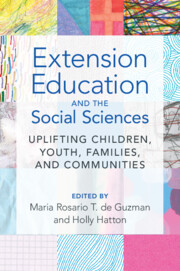Book contents
- Extension Education and the Social Sciences
- Extension Education and the Social Sciences
- Copyright page
- Contents
- Contributors
- Part I Overview of Extension and the Social Sciences
- Part II Addressing Key Issues in the Well-Being of Children, Youth, and Families
- Chapter 5 Extension’s Role in Supporting Young Children’s Well-Being
- Chapter 6 Supporting Youth through Family Engagement
- Chapter 7 The Application of Social Science in 4-H Youth Development
- Chapter 8 Promoting Healthy Behaviors and Communities through Food, Nutrition, and Health Extension Efforts
- Chapter 9 Youth Entrepreneurship Education
- Part III Looking Ahead: Emerging Issues and Trends
- Index
- References
Chapter 5 - Extension’s Role in Supporting Young Children’s Well-Being
from Part II - Addressing Key Issues in the Well-Being of Children, Youth, and Families
Published online by Cambridge University Press: 28 March 2024
- Extension Education and the Social Sciences
- Extension Education and the Social Sciences
- Copyright page
- Contents
- Contributors
- Part I Overview of Extension and the Social Sciences
- Part II Addressing Key Issues in the Well-Being of Children, Youth, and Families
- Chapter 5 Extension’s Role in Supporting Young Children’s Well-Being
- Chapter 6 Supporting Youth through Family Engagement
- Chapter 7 The Application of Social Science in 4-H Youth Development
- Chapter 8 Promoting Healthy Behaviors and Communities through Food, Nutrition, and Health Extension Efforts
- Chapter 9 Youth Entrepreneurship Education
- Part III Looking Ahead: Emerging Issues and Trends
- Index
- References
Summary
Early childhood is a time of profound growth and development and early experiences during this period have important implications for life-long health and development. Evidence for the benefit of investing in early childhood is so strong that it is considered a public health issue by many researchers and policymakers. This chapter explores efforts within Cooperative Extension in fostering health and well-being among young children, suggesting a holistic approach that involves supporting children’s parents and caregivers, early childhood educators, and fostering a positive context in which children can thrive. Extension continues to play important roles in providing culturally responsive education to families, working with families to cocreate knowledge, and assisting communities in supporting the well-being of young children for lifelong success. Specific examples of promising programs are provided to highlight the impactful work conducted by Extension to support young children around the country.
Keywords
- Type
- Chapter
- Information
- Extension Education and the Social SciencesUplifting Children, Youth, Families, and Communities, pp. 97 - 118Publisher: Cambridge University PressPrint publication year: 2024



